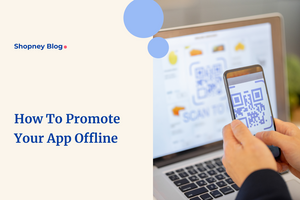
You’ve worked hours and weeks to finally launch your mobile app.
But despite all the hard work planning, coding, and developing, all you hear is crickets.
Ouch.
Currently, over 6.3 billion smartphone users and 1.14 billion tablet users globally peruse apps. The average person checks their mobile phone 262 times a day, probably scrolling endlessly on their favorite social media apps.
That is the sheer competition you’re up against.
Unfortunately, it’s no longer enough to have an app, for it to have success similar to TikTok or Instagram, you have to have all your ducks in a row.
Which is, in this context, a solid launch plan.
From app design to marketing strategy, understanding what makes an engaging app that users love to return to can be the difference between a successful launch and getting buried or overlooked.
We’ll deep dive into this today and share a comprehensive checklist of tasks that can help your mobile app stand apart.
Let’s begin!
Launch your Shopify store mobile app with this checklist
Your mobile app’s success in today's competitive market depends not just on functionality and design, but also on a well-executed launch strategy.
We’ve designed this checklist to guide you through key steps that can maximize your app’s potential for success, by creating a seamless and engaging experience for your users right from the beginning.
1. App Store optimization (ASO)
App Store Optimization, or ASO, is a critical factor for your app’s visibility and discoverability by potential users on the app store. Think of it as SEO for mobile apps.
Here are a few key aspects to prepare before launching your mobile app:
- Keyword Research: Identify and use relevant keywords in your app's title, description, and metadata to improve its ranking in search results. Use tools to research popular, relevant keywords in your app's category. You should also look at the keywords used by your competitors.
- App Title and Description: First impressions matter. Your app’s name or title should be catchy yet descriptive, incorporating the primary keywords we found in step one. It should make them look for your app’s description, which should clearly and in simple language, explain your app’s value proposition and features, using secondary keywords.
- Visuals: Your app's icon, screenshots, and preview videos should not only be eye-catching and representative of your app's features, it should also reassure them that your app will deliver on what is being promised. For example, if they see a short video of how easy it is to do what your app is made for, it will encourage faster downloads. achieve.
- Localization: Many Shopify brands cater to audiences worldwide. As a result, localization has become a critical aspect of having a sticky mobile app. Remember to adapt your app’s listing for different languages and regions to reach a broader audience and ensure your keywords, description, and visuals resonate with the local audience.
ASO is not a one-time task but an ongoing process. Beyond these points mentioned above, you will need to regularly keep your app updated to meet user needs, market trends and app feedback.
2. Beta testing and feedback
Like a pilot episode, that gives the audience a taste of the characters and plot, your app needs to undergo extensive beta testing.
But unlike TV shows that may never come to light because of a boring first episode, you get to work on the feedback and launch your app primed for success.
In the beta testing phase, you need to release the app to a limited audience and identify any potential issues.
Follow the below steps:
- Select Beta Testers: Choose a diverse group of users who represent your target audience to get varied feedback. Don’t just get people who are used to exploring and using apps, get people who may find the whole process difficult, to work on any missing information gaps.
- Set Objectives: Define clear objectives for your beta test, particularly usability, functionality, or specific features testing. Maintain open lines of communication and share clear instructions on how they can report any bugs they find or give feedback.
- Collect Feedback and Analyze: Use tools that help in easy collection of reviews and feedback and analyze data to identify the most common issues and patterns.
- Improve your app: Find solutions for high-priority bugs that impact user experience and implement any potential easy wins and implement changes based on feedback. Works not done yet- release the updated version to testers again for a second round.
3. Marketing strategy
You need to have a comprehensive marketing strategy for a successful app launch.
Here are a few critical aspects that you need to focus on:
- Understand Your Target Audience: Conduct thorough market research to understand your ideal audience's preferences and app usage behaviors. Use that knowledge to tailor your marketing tactics- for example, what makes them download an app? Where do they hear about new apps? Do they need an incentive?
- Create a Strong Brand Presence: App users like cohesion in branding. If you already have a website and social media pages, ensure that you are portraying a consistent brand voice and visual style for your app.
- Leverage Social Media and Influencers: With users spending hours on social media apps, it’s important that you have a strong presence and a loyal community to create buzz and engage with potential users. Use both organic posts and paid advertising for wider reach. You can also partner with micro-influencers that align with your offerings, if you’re bootstrapped, to tap into their follower base and gain credibility.
- Implement Email Marketing: Build an email list and engage subscribers with regular updates about your app. In fact, create anticipation and FOMO by sharing sneak peaks to nurture your leads.
4. Analytics tools
You have to know what’s working and what’s breaking in your app to make data-driven decisions.
To understand user behavior and measure performance, analytical tools need to be a priority to guide the app's ongoing improvement and marketing strategies.
Focus on:
- Selecting Tools: Choose tools that best fit your app's needs and goals, for example, user engagement, performance metrics, and monetization.
- Key Metrics Tracking: Monitor metrics such as daily active users (DAUs), session length, and retention rates. Also, keep track of acquisition metrics like download sources and cost per acquisition (CPA).
- Performance Analysis: Check your load times, crash rates, and any other technical glitches and bugs, and use those insights to optimize your app for a better user experience. Use these insights to optimize the app for better performance and user experience. Look at user interactions within your app to understand how they navigate through different sections, what features they use, and where they drop off.
- Monetization Tracking: Track revenue metrics like average revenue per user (ARPU) and lifetime value (LTV) to measure if your marketing efforts are giving the ROI you need.
- Custom Reports and Dashboards: Each business is unique. Try to find a tool that you can customize to create reports and dashboards that work for your needs.
5. Launch timing
Launching an app on Friday may mean you need to have an overnight shift of developers waiting to fix any important bugs or your users can face a delay and drop off. They might leave bad reviews which can significantly reduce the chances of more people downloading your app.
As a result, choosing the right time to launch your app is a vital decision that can impact your app’s success and overall momentum.
Here’s how you can find the right time for your app:
- Market Research and Trends: Look at market trends. Are there any industry-specific peak seasons or events? Avoid launching during times of high competition, like major holidays when the app market is saturated and customers tend to favor older, time-tested apps and brands.
- User Behavior: Understand when your target audience is most likely to download and use an app like yours and time your launch accordingly to boost visibility and downloads.
- Testing and Development Timeline: Ensure your launch timing aligns with your development and testing schedule. Ensure there is enough time for beta testing and that it’s not too close to the launch date.
6. Customer support
In a world where patience isn’t known to be a strong suit of app users, having an effective customer support strategy can do wonders. This can address user issues in real time and also reassure your users of your credibility and reduce uninstalls.
Here are a few elements to ensure you have sorted before the launch:
- Support Channels: Establish multiple channels for customer support, like in-app support through live chat, email, and social media that are easy to access.
- Responsive Support Team: Ensure you have a team ready to respond promptly to user inquiries and issues. Use AI chatbots to implement instant responses, reducing loads on your team which will also help them focus more on issues that need high human intervention. If your audience is across the globe, your team needs to be available for those accordingly.
- FAQs and Self-Help Resources: Many users don’t like reaching out to customer support- for them, provide a detailed FAQ section within your app. To increase engagement within your app, you can also build resources like onboarding tutorials, guides, and how-to videos.
7. Landing page and smart banners
A great landing page is indispensable for promoting your mobile app and enhancing user conversion rates. It’s what will convince them to download your app, and has larger real estate than the app store page to show your app’s most compelling features.
A great landing page depends on having a:
- User-Friendly Landing Page Design: Design an attractive and informative landing page that highlights your app's features and benefits. Make sure that it’s mobile-responsive and loads quickly.
- Clear Call-to-Action: A landing page is useless if it doesn’t clearly state what the next step is from a user’s POV. If your landing page is longer than two-folds, include your CTA, for example, a download link or sign-up form at multiple points through the page. It should be clear, visually prominent, and intriguing enough to encourage downloads.
- Smart Banners for Mobile Sites: If previously you were selling only through a mobile website, you need to implement smart banners to divert that traffic onto your app. Remember, no one likes an annoying pop-up so ensure these creatives are non-intrusive but noticeable, leading directly to your app store.
Need help to strategize your launch?
A launch checklist is just the beginning. Want to delve deeper? Take a look at these recommended posts below:
- Millennial and Gen Z Online Shopping Behavior - What Your Business on Shopify Needs to Know
- How to Get More Reviews and Ratings in and on your Shopify eCommerce Mobile App?
- How to Use Email Marketing to Increase Shopify eCommerce Mobile App Installs?
- How to Use Social Media to Promote Your Shopify Store Mobile App?
- How to Promote Your Mobile App and Get More Installs from Your Shopify Store Website?
Wrapping Up
Launching a mobile app in today's digital landscape requires a carefully thought approach.
From initial steps, like App Store Optimization and beta testing to creating a good marketing strategy, each step plays a crucial role in your new app's success.
We know what’s at stake and have worked with our clients to find what makes those app install rates double.



